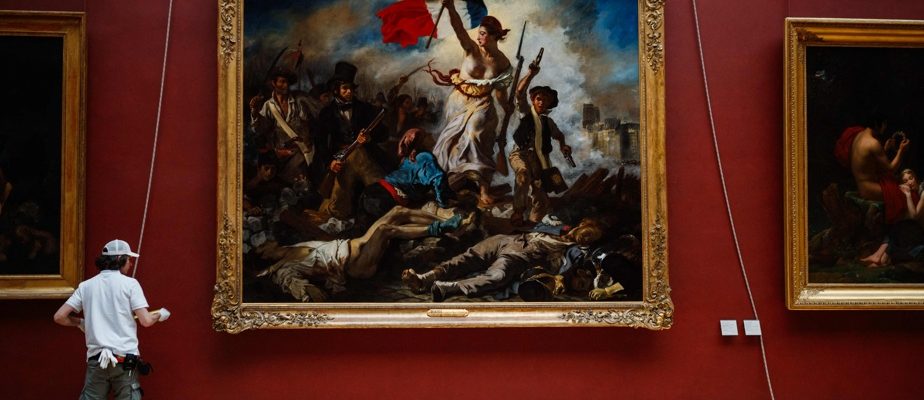(Paris) After more than six months of restoration, the public of the Louvre Museum in Paris will discover the true colors of a world icon of painting from Thursday: Liberty Leading the People by Delacroix, yellowed by decades of layers of varnish and grime.
“We are the first generation who will rediscover the color of Delacroix,” rejoices Sébastien Allard, director of the paintings department at the Louvre.
The painting which, outside the Louvre, could only be admired at its branch in Lens, in the north of France, and in Japan in 1999, represents an allegory of Liberty: a bare-breasted woman brandishing the blue cockade. white-red on a barricade in the middle of insurgents, in the heart of Paris, made by Eugène Delacroix in 1830.
“Until now, we lost the richness of the chromatic intensity, the planes, the whites, the shadows, all of this was unified under these yellowish layers,” underlines this manager who observed the metamorphosis of the painting in a room of the museum transformed into a restoration workshop.
Because, over time, eight layers of varnish were applied to the painting to enhance the colors before drowning them in a dull yellow mass, in which “dirt and dust” were also trapped, according to him.
The last major restoration dated from 1949. This was carried out as part of a campaign launched in 2019 for large 19th century formats.e century.
“Revelation”

PHOTO DIMITAR DILKOFF, AGENCE FRANCE-PRESSE
Grays, blacks, browns and whites once again illuminate the canvas, white smoke comes out of the weapons and dust rises above the barricades, the blue sky arises above the towers of Notre-Dame behind- plan like all the details of a story full of violence and exaltation.
And it’s a “revelation,” says Mr. Allard: grays, blacks, browns and whites once again illuminate the canvas, white smoke comes out of the weapons and dust rises above the barricades, the sky blue emerges above the towers of Notre-Dame in the background like all the details of a story full of violence and exaltation.
“It’s an enchantment to see a pictorial material in very good condition appear under the varnish with vibrant touches, we have the impression of being at the heart of creation,” Bénédicte Trémolières, one of the artists, told AFP. of the two restorers selected for this mission.
“Delacroix hid everywhere small touches of blue-white-red colors dotted in a subtle way as if echoing the flag and which were no longer perceptible at all,” adds his colleague, Laurence Mugniot, by showing “the blue pupil with a red touch” of a character or the “costume of a Swiss Guard”.
Like other large formats, the immense canvas (2.60 m high by 3.25 m wide without the frame) could not be transported to the workshop of the research and restoration center Museums of France (C2RMF).
To assess the extent of the work, the specialists relied on “archives and old photos” and carried out “meticulous analyzes of the canvas, passed through infrared, X-rays and ultraviolet”, Côme Fabre told AFP, curator in the painting department of the Louvre, in charge of the 19th centurye century.
After Delacroix

PHOTO DIMITAR DILKOFF, AGENCE FRANCE-PRESSE
To assess the extent of the work, the specialists relied on “archives and old photos” and carried out “careful analyzes of the canvas, passed through infrared, X-rays and ultraviolet”, specifies Côme Fabre, curator at the department of paintings from the Louvre, responsible for the 19the century.
The restorers then carried out “tests” on tiny parts of the painting. Equipped with binocular magnifying glasses and microscopes, “they notably discovered that certain alterations, including a brown mark on Liberty’s dress, had been added after Delacroix and that they could therefore be removed,” he reveals.
The painting arrived at the Louvre in 1874. It has always belonged to the French state, which purchased it during its first public exhibition in 1831.
If it represents the revolution of July 1830, many meanings have been given to it: “the Revolution, Marianne, the French Republic, France in general, repeated extensively on posters, at the time of the Liberation of Paris in 1944, on banknotes or stamps,” he explains.
In 2019, the artist Pascal Boyart, who signed PBOY, created a mural in eastern Paris entitled Liberty guiding the people of the yellow vests.
Because “Delacroix’s brilliant idea, according to Mr. Fabre, is to have succeeded in representing collective action in motion, which cannot be stopped, with men united around a woman, who embodies the idea of freedom.
